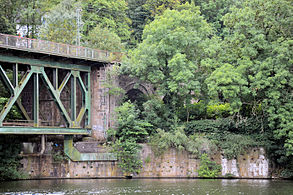Kettwig railway bridge
Coordinates: 51 ° 21 ′ 29 ″ N , 6 ° 56 ′ 33 ″ E
| Kettwig railway bridge | ||
|---|---|---|
| Kettwig railway bridge with the S 6 S-Bahn | ||
| Official name | Kettwig railway bridge | |
| use | Railway bridge | |
| Convicted | Ruhr Valley Railway | |
| Crossing of | Dysentery | |
| place | Eat , Kettwig | |
| construction | Truss bridge | |
| width | 20 m | |
| Load capacity | > 360 t | |
| Clear height | approx. 4.60 m | |
| start of building | 1869 | |
| completion | 1871, reconstruction in 1951 |
|
| opening | 1872 | |
| location | ||
|
|
||
| Above sea level | 50 m | |
The Kettwig railway bridge is a steel truss bridge located in Essen - Kettwig , which leads over the Ruhr at river kilometer 22.1 (from the mouth) and on which the Ruhr Valley Railway crosses the river. It forms the eastern border of the Kettwig Lake, which was built in 1950 . In the past, as now, a five-arch viaduct connects to the steel bridge in the southern part.
history
Today's Kettwig railway bridge is the old double-track Düsseldorf bridge that was rebuilt in 1951 and, in 1871, was the first of three railway bridges that ran here next to each other and served rail traffic.
prehistory
In 1863, the Prussian government commissioned the Bergisch-Märkische Eisenbahn-Gesellschaft (BME) to plan a connecting railway to the Ruhr Valley. As a result, it decided in 1866 to build the Düsseldorf - Kettwig - Kupferdreh railway line .
Düsseldorf Bridge
In 1869, the construction of the so-called Düsseldorf Bridge began. The river bridge was constructed from steel trusses, with the route being continued in the south on a five-arched viaduct. On October 23, 1871, test drives were made over the new bridge. Finally, with a load run of a train of twelve wagons loaded with gravel, it passed the building inspection.
The official inauguration of the bridge took place in 1872. This started the scheduled freight and passenger traffic from Essen via Kettwig to Düsseldorf.
Mülheim bridges
The first Mülheim bridge was built between 1873 and 1876 to the west, right next to the Düsseldorf bridge. It was a single-track steel box bridge, the track bed of which was a few meters lower than that of the Düsseldorf bridge, so that it crossed Werdener Strasse at ground level. The Düsseldorfer Brücke spans this to this day.
The Lower Ruhr Valley Railway , from Kettwig to Mülheim-Styrum via Mintard , Saarn and Broich , was initially connected to the existing Ruhr Valley Railway with the Mülheim Bridge, which was completed in March 1876 , operated by the Bergisch-Märkische Eisenbahn. After this line had been expanded to two tracks, a second Mülheim bridge was built again in 1900 to the west of the first Mülheim bridge, this time a steel bridge with two arches.
Remodeling in 1926
In 1926 all three bridges were reinforced and rebuilt. The reason was the completion of the Niederbergbahn from Kettwig via Heiligenhaus and Velbert to Wülfrath .
Second World War and the aftermath
On April 10, 1945, at around 7:30 a.m., all three bridges were blown up by German soldiers. The reason was American troops approaching from the north , who wanted to block their way across the Ruhr.
A few weeks after the end of the war, rail traffic was resumed. Trains from Düsseldorf ended at the temporary platform, called Pusch, where the S-Bahn - Kettwig Stausee stop is today. Trains from Mülheim ended at Kettwig station in front of the bridge, near the St. Joseph Church.
From 1948 the first rubble of the three bridges was cleared. Only the double-track Düsseldorf bridge was rebuilt in 1950. It could be put into operation in March 1951 after a stress test of three locomotives with a combined total weight of 360 tons. The railroad then ran again from Kettwig to Düsseldorf or via Velbert to Wuppertal . Parts of the two Mülheim bridges that had not been rebuilt, which spanned the Ruhr from the north bank to the first pillar, were dismantled in April 1957. These two bridge elements were brought to Wesel and span the Lippe to this day .
From 1953 there was a makeshift stop called Kettwig Stausee for the route from Mülheim-Styrum, below today's stop of the same name. There were opportunities to change to the line to Velbert until passenger traffic on the connection to Mülheim was discontinued on September 1, 1968 and the line was finally closed for freight traffic until 1978.
Pictures today
Abutment of the former Mülheim bridges on the north bank
literature
- Christoph Schmitz: The Ruhr bridges (p. 429 to 431). Münster: Ardey Verlag, 2004; ISBN 3-87023-311-7
- Friedhelm Stöters: Die Ruhrtalbahn , self-published by the author, Duisburg 1993
- Martin Menke: Die Ruhrtalbahn , self-published by Eisenbahnfreunde Mülheim an der Ruhr, 1999
Web links
- Kettwig railway bridge. In: Structurae
- Historical photos on a private homepage
- Description of all locations on this themed route as part of the Route of Industrial Culture







